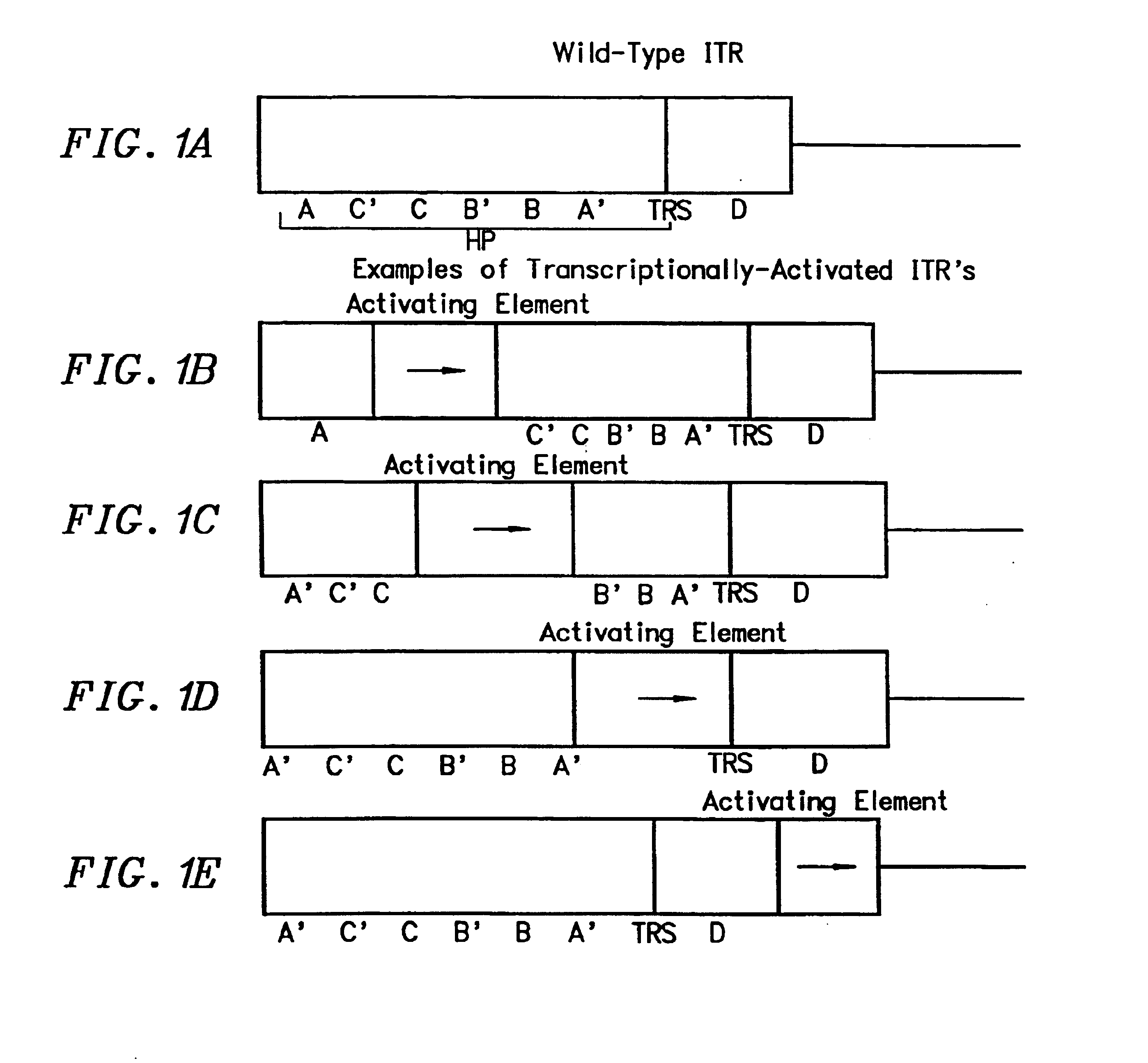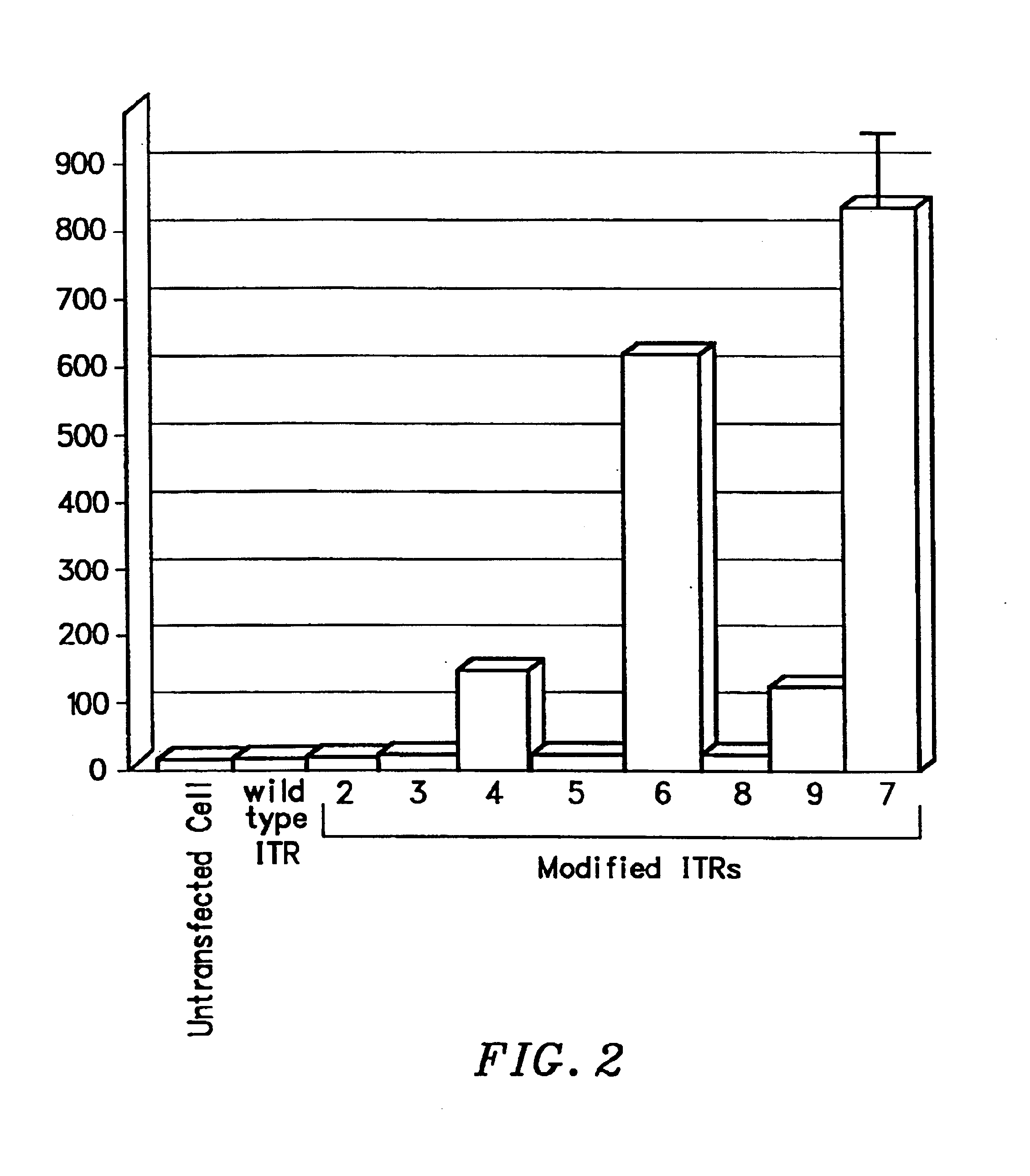Transcriptionally-activated AAV inverted terminal repeats (ITRs) for use with recombinant AAV vectors
a technology of transcriptional activity and inverted terminal repeats, which is applied in the field of recombinant adenoassociated virus (aav) vectors, can solve the problems of limited capacity of aav capsids to package dna, and achieve the effects of increasing transcriptional activity, increasing transcriptional activity, and increasing transcriptional activity
- Summary
- Abstract
- Description
- Claims
- Application Information
AI Technical Summary
Benefits of technology
Problems solved by technology
Method used
Image
Examples
example 1
Construction of Transcriptionally-activated ITRs for AAV Vectors
[0111]By way of illustration, a series of transcriptionally-activated ITRs have been constructed. All transcriptionally active elements were constructed using pairs of complementary oligonucleotides with the defined sequences. Typically, when the complementary oligonucleotides were annealed, XhoI-compatible ends were generated.
example 1-1
Transcriptional Element 1: TATA Box / CMV Sequence (40-bp)
[0112]
oligonucleotide 1 (SEQ ID NO:1):5′TCGAGTATATAAGCAGAGCTCGTTTAGTGAACCGTCAGAG 3′oligonucleotide 2 (SEQ ID NO:2):5′TCGACTCTGACGGTTCACTAAACGAGCTCTGCTTATATAC 3′
[0113]The double underlined sequence is derived from an element of the CMV promoter. Lehner et al., 1991, J. Clin. Microbiol. 29: 2494-2502. It includes the TATA box (bold, italics) and the sequences up to and including the transcriptional start site.
[0114]This transcriptional element was not cloned into the AAV-CAT vector but this sequence is a subsequence of other TATA box-containing transcriptional elements described below.
example 1-2
Transcriptional Element 2: 27-bp Element (Phospholipase A2 Gene) with InR (Synthetic Initiation Region)(50-bp)
[0115]
oligonucleotide 1 (SEQ ID NO:3):5′TCGAGTTCTCCCTCTTCCCCTTTAATTCCACCTTAAAACATCTGCAAAAC 3′oligonucleotide 2 (SEQ ID NO:4):5′TCGAGTTTTGCAGATGTTTTAAGGTGGAATTAAAGGGGAAGAGGGAGAAC 3′
[0116]This element is derived from the cytosolic phospholipase A2 (cPLA2) gene promoter and contains no TATA box. Miyashita et al., 1995, Nucleic Acids Res. 23: 293-301. Transcriptional element 2 comprises the 27-nucleotide fragment, along with adjoining sequences, in total comprising sequences from −30 to +14 (underlined) relative to the major transcriptional start site of the cPLA2 gene. Extra sequence at the ends of the oligonucleotides form the sticky ends of a XhoI restriction site. The fragment also contains the sequence CTCCCTCT (bold), which is similar (mismatch underlined) to the initiator element (CTCANTCT) of the terminal deoxynucleotidyltransferase (TdT) gene. Smale et al., 1989.
PUM
| Property | Measurement | Unit |
|---|---|---|
| Fraction | aaaaa | aaaaa |
| Length | aaaaa | aaaaa |
Abstract
Description
Claims
Application Information
 Login to View More
Login to View More - R&D
- Intellectual Property
- Life Sciences
- Materials
- Tech Scout
- Unparalleled Data Quality
- Higher Quality Content
- 60% Fewer Hallucinations
Browse by: Latest US Patents, China's latest patents, Technical Efficacy Thesaurus, Application Domain, Technology Topic, Popular Technical Reports.
© 2025 PatSnap. All rights reserved.Legal|Privacy policy|Modern Slavery Act Transparency Statement|Sitemap|About US| Contact US: help@patsnap.com


